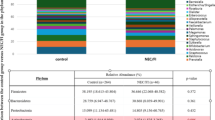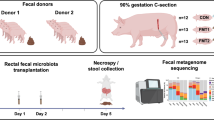Abstract
Neonatal necrotizing enterocolitis (NEC) is an inflammatory intestinal disorder affecting preterm infants. Intestinal bacteria have an important function; however no causative pathogen has been identified. The purpose of this study was to determine if there are differences in microbial patterns that may be critical to the development of this disease. Fecal samples from 20 preterm infants, 10 with NEC and 10 matched controls (including 4 twin pairs) were obtained from patients in a single site level III neonatal intensive care unit. Bacterial DNA from individual fecal samples was PCR-amplified and subjected to terminal restriction fragment length polymorphism analysis and library sequencing of the 16S rRNA gene to characterize diversity and structure of the enteric microbiota. The distribution of samples from NEC patients distinctly clustered separately from controls. Intestinal bacterial colonization in all preterm infants was notable for low diversity. Patients with NEC had even less diversity, an increase in abundance of Gammaproteobacteria, a decrease in other bacteria species, and had received a higher mean number of previous days of antibiotics. Our results suggest that NEC is associated with severe lack of microbiota diversity that may accentuate the impact of single dominant microorganisms favored by empiric and widespread use of antibiotics.
Similar content being viewed by others
Log in or create a free account to read this content
Gain free access to this article, as well as selected content from this journal and more on nature.com
or
References
Abdo Z, Schuette UM, Bent SJ, Williams CJ, Forney LJ, Joyce P (2006). Statistical methods for characterizing diversity of microbial communities by analysis of terminal restriction fragment length polymorphisms of 16S rRNA genes. Environ Microbiol 8: 929–938.
Bell MJ, Bell MJ, Shackelford P, Feigin RD, Ternberg JL, Brotherton T . (1979a). Epidemiologic and bacteriologic evaluation of neonatal necrotizing enterocolitis. J Pediatr Surg 14: 1–4.
Bell MJ, Feigin RD, Ternberg JL . (1979b). Changes in the incidence of necrotizing enterocolitis associated with variation of the gastrointestinal microflora in neonates. Am J Surg 138: 629–631.
Bell MJ, Ternberg JL, Feigin RD, Keating JP, Marshall R, Barton L et al. (1978). Neonatal necrotizing enterocolitis. Therapeutic decisions based upon clinical staging. Ann Surg 187: 1–7.
Bin-Nun A, Bromiker R, Wilschanski M, Kaplan M, Rudensky B, Caplan M et al. (2005). Oral probiotics prevent necrotizing enterocolitis in very low birth weight neonates. J Pediatr 147: 192–196.
Chang JY, Antonopoulos DA, Kalra A, Tonelli A, Khalife WT, Schmidt TM . (2008). Decreased diversity of the fecal Microbiome in recurrent Clostridium difficile-associated diarrhea. J Infect Dis 197: 435–438.
Claud EC, Walker WA . (2001). Hypothesis: inappropriate colonization of the premature intestine can cause neonatal necrotizing enterocolitis. FASEB J 15: 1398–1403.
Conte MP, Sschippa S, Zamboni I, Penta M, Chiarini F, Seganti L et al. (2006). Gut-associated bacterial microbiota in paediatric patients with inflammatory bowel disease. Gut 55: 1760–1767.
Cotten CM, taylor S, Stoll B, Goldberg RN, Hansen NI, Sanchez PJ et al. (2009). Prolonged duration of initial empirical antibiotic treatment is associated with increased rates of necrotizing enterocolitis and death for extremely low birth weight infants. Pediatrics 123: 58–66.
Dicksved J, Halvarson J, Rosenquist M, Jarnerot G, Tysk C, Apajalahti J et al. (2008). Molecular analysis of the gut microbiota of identical twins with Crohn's disease. ISME J 2: 716–727.
Eckburg PB, Bik EM, Bernstein CN, Purdom E, Dethlefsen L, Sargent M et al. (2005). Diversity of the human intestinal microbial flora. Science 308: 1635–1638.
Gewolb IH, Schwalbe RS, Taciak VL, Harrison TS, Panigrahi P . (1999). Stool microflora in extremely low birthweight infants. Arch Dis Child Fetal Neonatal Ed 80: F167–F173.
Goldmann DA, JLeclair Macone A . (1978). Bacterial colonization of neonates admitted to an intensive care environment. J Pediatr 93: 288–293.
Good IJ . (1953). The population frequencies of species and the estimation of population parameters. Biometrika, 237–264.
Gronlund MM, Lehtonen OP, Eerola E, Kero P . (1999). Fecal microflora in healthy infants born by different methods of delivery: permanent changes in intestinal flora after cesarean delivery. J Pediatr Gastroenterol Nutr 28: 19–25.
Harmsen HJ, Wildeboer-Veloo AC, Raangs GC, Wagendorp AA, Klijn N, Bindels JG . (2000). Analysis of intestinal flora development in breast-fed and formula-fed infants by using molecular identification and detection methods. J Pediatr Gastroenterol Nutr 30: 61–67.
Hooper LV, Bry L, Falk PG, Gordon JI . (1998). Host–microbial symbiosis in the mammalian intestine: exploring an internal ecosystem. Bioessays 20: 336–343.
Hooper LV, Wong MH, Thelin A, Hansson L, Falk PG, Gordon JI . (2001). Molecular analysis of commensal host–microbial relationships in the intestine. Science 291: 881–884.
Hoyos AB . (1999). Reduced incidence of necrotizing enterocolitis associated with enteral administration of Lactobacillus acidophilus and Bifidobacterium infantis to neonates in an intensive care unit. Int J Infect Dis 3: 197–202.
Huber T, Faulkner G, Hugenholtz P . (2004). Bellerophon: a program to detect chimeric sequences in multiple sequence alignments. Bioinformatics 20: 2317–2319.
Kosloske AM . (1994). Epidemiology of necrotizing enterocolitis. Acta Paediatr Suppl 396: 2–7.
Kuehl CJ, Wood HD, Marsh TL, Schmidt TM, Young VB . (2005). Colonization of the cecal mucosa by Helicobacter hepaticus impacts the diversity of the indigenous microbiota. Infect Immun 73: 6952–6961.
Kumar S, Nei M, Dudley J, Tamura K . (2008). MEGA: a biologist-centric software for evolutionary analysis of DNA and protein sequences. Brief Bioinform 9: 299–306.
Lepage P, Seksik P, Sutren M, de la Cochetiere MF, Jian R, Marteau P . (2005). Biodiversity of the mucosa-associated microbiota is stable along the distal digestive tract in healthy individuals and patients with IBD. Inflamm Bowel Dis 11: 473–480.
Lin HC, Su BH, Chen AC, Lin TW, Tsai CH, Yeh TF . (2005). Oral probiotics reduce the incidence and severity of necrotizing enterocolitis in very low birth weight infants. Pediatrics 115: 1–4.
Lozupone C, Hamady M, Knight R . (2006). UniFrac—an online tool for comparing microbial community diversity in a phylogenetic context. BMC Bioinformatics 7: 371.
Lozupone C, Knight R . (2005). UniFrac: a new phylogenetic method for comparing microbial communities. Apl Environ Microbiol 71: 8228–8235.
Lucas A, Cole TJ . (1990). Breast milk and neonatal necrotising enterocolitis. Lancet 336: 1519–1523.
Millar MR, MacKay P, Levene M, Langdale V, Martin C . (1992). Enterobacteriaceae and neonatal necrotising enterocolitis. Arch Dis Child 67 (1 Spec No): 53–56.
Palmer C, EMBik Digiulio DB, Relman DA, Brown PO . (2007). Development of the human infant intestinal microbiota. PLoS Biol 5: e177.
Panigrahi P, Sgupta S, Gewolb IH, Morris Jr JG . (1994). Occurrence of necrotizing enterocolitis may be dependent on patterns of bacterial adherence and intestinal colonization: studies in Caco-2 tissue culture and weanling rabbit models. Pediatr Res 36 (1 Part 1): 115–121.
Penders J, Thijs C, Vink C, Stelma FF, Snijders B, Kummeling I et al. (2006). Factors influencing the composition of the intestinal microbiota in early infancy. Pediatrics 118: 511–521.
Relman DA . (1999). The search for unrecognized pathogens. Science 284: 1308–1310.
Salyers AA, West SE, Vercellotti JR, Wilkins TD . (1977). Fermentation of mucins and plant polysaccharides by anaerobic bacteria from the human colon. Appl Environ Microbiol 34: 529–533.
Schloss PD, Handelsman J . (2005). Introducing DOTUR, a computer program for defining operational taxonomic units and estimating species richness. Appl Environ Microbiol 71: 1501–1506.
Schwiertz A, Gruhl B, Lobnitz M, Michel P, Radke M, Blaut M . (2003). Development of the intestinal bacterial composition in hospitalized preterm infants in comparison with breast-fed, full-term infants. Pediatr Res 54: 393–399.
Stappenbeck TS, Hooper LV, Gordon JI . (2002). Developmental regulation of intestinal angiogenesis by indigenous microbes via Paneth cells. Proc Natl Acad Sci U S A 99: 15451–15455.
Stoll BJ . (1994). Epidemiology of necrotizing enterocolitis. Clin Perinatol 21: 205–218.
Sturm R, Staneck JL, Stauffer LR, Neblett WW . (1980). Neonatal necrotizing enterocolitis associated with penicillin-resistant, toxigenic Clostridium butyricum. Pediatrics 66: 928–931.
Thompson JD, Gibson TJ, Plewniak F, Jeanmougin F, Higgins DG . (1997). The CLUSTAL_X windows interface: flexible strategies for multiple sequence alignment aided by quality analysis tools. Nucleic Acids Res 25: 4876–4882.
Turnbaugh PJ, Ley RE, Mahowald MA, Magrini V, Mardis ER, Gordon JI . (2006). An obesity-associated gut microbiome with increased capacity for energy harvest. Nature 444: 1027–1031.
Vercellotti JR, Salyers AA, Bullard WS, Wilkins D . (1977). Breakdown of mucin and plant polysaccharides in the human colon. Can J Biochem 55: 1190–1196.
Young VB, Schmidt TM . (2004). Antibiotic-associated diarrhea accompanied by large-scale alterations in the composition of the fecal microbiota. J Clin Microbiol 42: 1203–1206.
Acknowledgements
This study was supported by National Institutes of Health grants HD043839 and HD 059123 (to E Claud) and DK047722 and HG4858 (to E Chang). The Digestive Disease Research Core Center of the University of Chicago (DK42086) provided core facilities and services used for this study.
Author information
Authors and Affiliations
Corresponding author
Additional information
Supplementary Information accompanies the paper on The ISME Journal website (http://www.nature.com/ismej)
Rights and permissions
About this article
Cite this article
Wang, Y., Hoenig, J., Malin, K. et al. 16S rRNA gene-based analysis of fecal microbiota from preterm infants with and without necrotizing enterocolitis. ISME J 3, 944–954 (2009). https://doi.org/10.1038/ismej.2009.37
Received:
Revised:
Accepted:
Published:
Issue date:
DOI: https://doi.org/10.1038/ismej.2009.37
Keywords
This article is cited by
-
Human milk cream alters intestinal microbiome of preterm infants: a prospective cohort study
Pediatric Research (2024)
-
Prevention Strategies and Management of Necrotizing Enterocolitis
Current Treatment Options in Pediatrics (2024)
-
Effects of prophylactic probiotics supplementation on infants born very preterm or very low birth weight
Journal of Perinatology (2023)
-
Atypical behavioral and thermoregulatory circadian rhythms in mice lacking a microbiome
Scientific Reports (2022)
-
The relationship between the gut microbiome and the risk of respiratory infections among newborns
Communications Medicine (2022)



